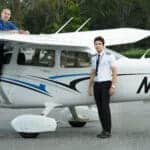DGCA CPL License Process: 8 Ultimate Steps to Get Your Pilot License in India

Dreaming of becoming a commercial pilot in India? It all starts with understanding the DGCA CPL license process—the official pathway to earning your Commercial Pilot License under India’s aviation authority.
From your initial Class 1 medical to passing DGCA exams and logging 200+ flight hours, every step is regulated and recorded through the eGCA portal. Missing a single detail can lead to delays, rejections, or lost time.
In India, no one can apply for pilot jobs or build airline hours without this license. Whether your goal is to fly for IndiGo, Air India, or even international carriers, the DGCA CPL is your official ticket to the cockpit.
This guide breaks down the steps of the DGCA CPL license process, giving you a clear flight path from zero experience to airline-ready pilot—without wasting time or money.
DGCA CPL License Process Begins with Medical Exams
Every aspiring pilot in India must start the DGCA CPL license process with medical clearance. This isn’t just a formality—it’s the first checkpoint that determines whether you’re physically and mentally fit to fly.
The process begins with a Class 2 Medical Examination, a general health check conducted by DGCA-approved doctors. This initial step is essential for anyone who wants to begin flying as a student pilot. Once you pass, your medical file is created on the DGCA’s eGCA portal—a digital record that tracks your progress throughout your pilot training.
After completing your initial training and before applying for your Commercial Pilot License, you’ll need to undergo a more rigorous Class 1 Medical Examination. This includes vision and hearing tests, bloodwork, ECG, and checks for any underlying health issues. It’s conducted only at DGCA-certified centers and is mandatory for CPL issuance.
Skipping or delaying your medicals can derail your progress, so it’s crucial to prioritize them early. In the larger timeline of the DGCA CPL license process, this step ensures you’re legally eligible to proceed with flight training.
Enroll in a DGCA-Approved School to Begin CPL License Process
Once medical clearance is secured, the next phase of the DGCA CPL license process is enrolling in a DGCA-approved flight school. This decision can make or break your aviation career, so choose carefully.
DGCA-recognized schools in India are required to follow strict training protocols. They must operate with certified instructors, regularly maintained aircraft, and provide structured ground school sessions to prepare students for DGCA theory exams. Before committing, review each academy’s fleet quality, instructor credentials, and student success rates.
Many flight schools also offer different training models. For example, Florida Flyers Academy India delivers a globally aligned program with both FAA and DGCA standards—ideal for students who may want to fly internationally in the future.
By selecting the right school, you’re not just signing up for flying lessons. You’re securing the foundation for every future milestone in the DGCA CPL license process, from your first solo flight to your final license application.
DGCA CPL License Process Includes Ground School + Written Exams
The academic foundation of the DGCA CPL license process lies in ground school training. Before you can qualify for a commercial pilot license, you must develop a strong grasp of aviation theory—covering everything from weather patterns to aircraft systems and Indian air law.
Ground school typically lasts between 3 to 6 months, depending on the school’s curriculum and your personal pace. During this time, you’ll study core DGCA subjects such as Air Navigation, Aviation Meteorology, Air Regulations, and Technical General. These topics are essential—not just for passing exams, but for making real-time decisions in the cockpit.
Once ground training is complete, you must appear for DGCA-written examinations held periodically throughout the year. Scoring a pass in all required subjects is mandatory before applying for your CPL. Each exam is conducted under strict supervision, and only candidates who are medically fit and registered on the eGCA portal are allowed to appear.
Completing this academic phase is non-negotiable. Without successfully passing these exams, your journey through the DGCA CPL license process cannot progress to flight testing or final application.
Log 200 Hours of Flight Time for CPL License Issue
Alongside theory, hands-on flying experience is the heart of the DGCA CPL license process. As per DGCA regulations, every candidate must complete a minimum of 200 hours of flight time to qualify for the Commercial Pilot License.
These hours aren’t just random flights—they’re structured to build diverse, real-world skills. Your logbook must include:
- 100 hours as Pilot-in-Command (PIC)
- 20 hours of cross-country flying, including a solo cross-country of at least 300 nautical miles
- 15 hours of instrument time
- 5 hours of night flying, including solo night circuits
Flight training must be conducted under DGCA-approved aircraft and certified instructors, with every flight properly recorded and verified in your pilot logbook. Missing entries, incomplete hours, or errors in documentation can cause delays during your final CPL evaluation.
Logging these 200 hours is more than a regulatory requirement—it’s a personal transformation. It’s where knowledge meets skill and where your identity as a pilot is forged. This is the longest and most intensive stage of the DGCA CPL license process, but also the most rewarding.
Pass the RTR (Aero) Exam – Mandatory for DGCA CPL License
As you near the final stages of the DGCA CPL license process, one often overlooked but crucial requirement is passing the RTR (Aero) exam—short for Radio Telephony Restricted (Aeronautical). This certification is mandatory for any pilot who wishes to operate aircraft radio equipment during live flights.
The exam is conducted by India’s Wireless Planning and Coordination (WPC) Wing, a division under the Ministry of Communications. It ensures that pilots are proficient in aviation radio communication—an essential skill for real-world flight operations.
The RTR (Aero) exam consists of two stages:
- A written test that assesses your knowledge of radio procedures, phraseology, and communication standards.
- A viva (oral exam) where candidates are tested on their ability to handle simulated radio scenarios and real-time ATC interactions.
Without this license, you cannot legally communicate over aviation frequencies, which means you can’t operate as a Pilot-in-Command. That’s why clearing the RTR (Aero) exam is a non-negotiable milestone in the DGCA CPL license process.
File Computer Number to Proceed with DGCA CPL License Process
Before you can even book a slot for the DGCA theory exams, you must obtain a Computer Number—a unique ID that tracks your academic progress with the DGCA. Think of it as your permanent pilot student registration number.
To apply, visit the Pariksha portal, the official platform used by DGCA to manage examination applications. The process requires you to upload:
- A scanned copy of your Class 10 and 12 certificates (with Physics and Mathematics)
- A government-issued ID proof
- A recent passport-size photo and signature
- Flight school enrollment documents (if applicable)
Once verified, your Computer Number becomes your gateway to all future DGCA exams. Without it, you can’t register for Air Navigation, Meteorology, or other written papers.
This step is purely administrative, but critical. Any mistakes or missing documents can delay your CPL timeline. Filing early in your journey helps streamline the rest of the DGCA CPL license process and keeps your training on schedule.
Final Step in DGCA CPL License Process: Submit eGCA Application
After completing your flight training, clearing exams, and securing the RTR license, the final step in the DGCA CPL license process is submitting your official license application through the eGCA portal.
This online platform is DGCA’s centralized system for all pilot-related documentation. At this stage, you’ll be required to upload:
- Scanned flight logs with verified entries and signatures
- Pass certificates for DGCA ground exams and the RTR (Aero) exam
- Valid Class 1 Medical report
- Proof of 200+ flight hours completed as per regulatory requirements
Once your documents are submitted, DGCA initiates a thorough verification process. If everything checks out, your Commercial Pilot License (CPL) will be issued electronically through your eGCA dashboard. This marks the formal completion of the DGCA CPL license process—granting you legal authority to fly commercially in India.
Keep in mind: any discrepancies or missing documents can cause delays, so double-check everything before submission.
After Completing DGCA CPL License Process – What’s Next?
Congratulations—you’ve completed the DGCA CPL license process and are now a certified commercial pilot. But your journey doesn’t end here.
The next logical step is to pursue a Type Rating, which is specialized training on specific aircraft models like the Airbus A320 or Boeing 737. This is typically required by airlines before hiring you as a First Officer.
With your CPL in hand, you’re also eligible to apply for jobs with Indian airlines such as IndiGo, Air India, Akasa, and even international carriers—provided you meet their hiring criteria.
To stay flight-ready, you must maintain the validity of your Class 1 Medical Certificate, which requires periodic renewals every 6 to 12 months, depending on your age and health status.
In short, earning a CPL opens doors—but staying in the sky means staying current, staying trained, and continuously improving your flight experience.
Conclusion
Completing the DGCA CPL license process isn’t just about getting a certificate—it’s about transforming from a student into a professional aviator ready for commercial cockpit responsibilities.
From your first medical exam to your final eGCA submission, every step is designed to test not just your skills but your discipline, attention to detail, and commitment to safety. It’s a challenging path that filters out the unprepared and builds the foundation for a career in aviation.
Once licensed, you’re no longer a trainee—you’re now eligible to move into type rating programs, build multi-crew experience, and begin applying to airlines in India or abroad. But the work doesn’t stop there. Staying current with your Class 1 Medical, updating logbooks, and continuously upgrading your flying experience are part of life as a professional pilot.
The DGCA CPL license process is more than a checklist—it’s your gateway into one of the world’s most respected professions. If you’re committed, well-trained, and detail-oriented, the sky isn’t the limit—it’s your workplace.
Florida Flyers Flight Academy India offers complete guidance through every phase of the DGCA CPL license process—from initial Class 2 medical to eGCA application filing. Get FAA + DGCA-aligned training, experienced instructors, and airline-focused career support.
FAQ Section About the DGCA CPL License Process
How long does the DGCA CPL license process take from start to finish?
The entire process typically takes 18 to 24 months, depending on training pace, weather conditions, school availability, and exam schedules. Delays can occur if medicals, exam results, or logbook entries are incomplete.
What documents are required for the DGCA CPL application?
You’ll need your Class 10 and 12 certificates, passport, Class 1 and Class 2 medical certificates, RTR license, DGCA exam results, flight logbook, and a completed eGCA application form with verified entries.
Can I do CPL training abroad and convert it under DGCA?
Yes. If you train abroad, you can convert your foreign CPL to an Indian CPL through a license conversion process. This involves clearing the DGCA theory exams, Class 1 medical, and additional paperwork under Indian aviation regulations.
What’s the minimum flight time needed in India?
To obtain a DGCA CPL, you must log a minimum of 200 hours of flight time, which includes solo, cross-country, instrument, and night flying—under DGCA-approved aircraft and instructors.
Can I apply for CPL with Class 2 medical?
No. You must have a valid Class 1 Medical Certificate issued by a DGCA-approved center to apply for a CPL. Class 2 is only valid for student pilot activities and ground school.
Contact the Florida Flyers Flight Academy Team today at 91 (0) 1171 816622 to learn more about the Private Pilot Ground School Course.



Table of Contents






